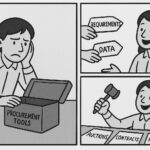Following last week’s article, you’ve decided you need more contracts to add value and reduce your supply chain risk. Maybe you have a couple of blanket POs and want written terms, or maybe you have a couple contracts on supplier paper. But now what? What does the actual activity of exchanging redlines, negotiating terms, getting approval, and fitting contract management into your organization look like? Today’s article is about the tactical implications of contract management: templates, how negotiating terms works, some best practices, and how contract managers fit into your organization.
Templates
Negotiating a contract starts with a template. There are a variety of places to get a template, make sure the one you find or build has some of the basic clauses referred to in last week’s article (whichever are relevant to your business). Sources might include your legal team (if you have one), outside legal counsel (make sure you find someone with supplier contract expertise), my deep dive series on contract negotiation, or even ChatGPT. Of course, if you use ChatGPT or any other large language model AI, be very careful and definitely run that contract through a professional for review before using. I do NOT recommend using “supplier paper,” which is a template the supplier provides. Your template should start off in YOUR favor, and a supplier template will definitely be in their favor. Some suppliers insist on using their own template in order to do business with you, but I always consider that to be a last resort. If they do so, try to get that template in an editable form (not a pdf) and get it moved at least a little in your direction. A larger or more mature company might have the following templates available:
- Materials contract – this is for buying physical goods, whether for inventory and production or to be drop-shipped straight to a customer. It focuses on moving goods around, quality issues, risk if something happens to the materials, what happens to obsolete inventory and inventory in progress if cancelled, etc.
- Services contract – this is for buying services, such as contracting or maintenance or other labor services. It focuses more on liability, safety concerns, training, regulations, and any facility requirements.
- Miscellaneous contract – I’ve seen a lot of variants where there is a “lighter” contract for things like lawn care and snow removal, plumbing and electrical work, etc. These are usually a lot shorter, focus only on the most important pieces of that type of work, and can be quick to sign and negotiate (they really should be designed so suppliers can simply sign them with little or no negotiation and should balance risk between the parties). These are a slippery slope, consider putting a spend threshold (such as $5000 or $10,000) on these lighter contracts or you will find them quickly used for absolutely everything.
- IT contract – the most common “supplier paper” contract is for IT software. Each software company tends to insist their software is unique and has special requirements in the contract. While this might be true for a few, very large contracts (such as for your ERP system), it is still useful to have your own template if you buy a lot of software. Make sure there’s a service level agreement clause with a penalty or credit if the supplier does not meet their uptime obligations. Note that a 99.9% uptime allows a system to be down about 45 minutes in a month, a 99% uptime allows a system to be down about 7 hours in a month (an entire work day), and a 97% uptime allows a system to be down about 21 hours in a month (that’s almost three days!). So do your math before you agree on an acceptable uptime percentage.
I have also seen separate templates for hazardous materials, logistics, environmental services, and waste disposal when those were large parts of a company’s business.
The Redline Process
Whew! Templates was a larger topic than I expected! So let’s talk about the nitty-gritty of sending redlines back and forth. Typically the buyer sends the chosen contract template to the supplier for redline, usually as a Word document. The supplier then tracks their changes and sends back a “redlined” contract where their changes are highlighted in a different font color, and there may be comments as to why they made certain changes. At this point the buyer/company accepts any redlines that are acceptable (i.e. changing payment terms from Net 60 to Net 45), replies to comments/reverses changes that are unacceptable, and determines which changes are never going to be acceptable and which can be modified to be acceptable to both parties. It has become very common for suppliers to add a limitation of liability to contracts, which I talk about in more detail in this article.
At this point, the buyer sends a “redline response” with the acceptable, unacceptable, and acceptable-with-modifications terms back to the supplier for review. I usually target each of these contract “turns” to take five business days. They very seldom do. But they definitely should not take more than a month. After about two weeks of a supplier holding a contract for review (either initially or for a response), I’m following up every week or even every few days to keep that review moving.
In many contract teams, this process of passing redlines back and forth continues for months. I’m an advocate for scheduling a conference call to talk through the redlines if the supplier does not accept the contract the second time they see it (after the supplier reviews the template, the buyer reviews and responds to redline, and the supplier reviews redline response). Passing things back and forth via email or contract management software seldom drives final agreement, and usually both parties simply need to get onto a phone to understand what the other party is trying to accomplish for risk and value.
Hopefully at this point (either before or after a call), the buyer and supplier have reached contract agreement. The next step is approval and signature. Some companies care whether they sign an agreement first or second, some find it less important. In our modern day of electronic signatures, it’s less relevant than ever who signs first. E-signature suppliers like Docusign and Adobe Sign can even send the agreement to both parties simultaneously, making the order of signature irrelevant.
Remember that a contract isn’t done once it’s fully signed/executed. While not a “living document,” it is an active one. You still need to make sure the supplier performs the contract according to the contract terms, the contract doesn’t need any modification as you implement it, and that you have a plan for when that contract expires (bid the category again? Extend the contract?). The most common non-compliance I see is when a supplier agrees to one payment term on its contract but then prints another one on every invoice and so tends to get the payment terms printed on its invoices.
A note on approvals: If you don’t work in an approval-heavy organization, congratulations! (Seriously.) Approvals can be an absolute nightmare and often show up when signing a contract. Before a CEO, C-suite executive, or VP signs a contract, they usually want to know that someone below them in the organization has approved it. These can be good because the team members who need the contract can make sure it has acceptable risk levels and value and that it was negotiated according to their needs. However, in many organizations there are 3-5 approvals before the contract goes to the signing authority. This is 3-5 people who all think the others in the group carefully reviewed the contract, understand it, and approve it. They all think someone else is taking accountability. So I highly recommend exactly ONE approval before a signatory. No matter how big your organization is. One person should be responsible for the risk and value of that contract, and should actually take responsibility for the approval. I also highly recommend a one-page summary of the contract for internal purposes only (sometimes called a contract abstract), outlining the value of the contract, the major changes to the template accepted, how it should be used, and any other relevant details in plain language.
How Contract Management Fits Into Your Org Chart
If you are going to negotiate many contracts, you probably need at least one team member to do that work. Personally, if I have two procurement team members I’m going to set toward strategic work, I would rather have one category manager and one contract manager than have two category managers who also negotiate contracts. The skillsets are simply not the same. The contract manager should be someone meticulous, but who understands that sometimes “done is better than perfect” and won’t try to die on each and every contract term hill. They should be adept with tracked changes in Microsoft Word, able to use that aspect of the tool. In the “ten people you meet in supply chain,” the contract manager is probably the Old Guard, the Steady Eddy, or even the Bustler (especially if you have an indirect or services contract manager).
A contract manager role is a senior technical role, and can easily be a terminal role for someone’s career. It’s a job you can continue to grow in, bring value to, and use experience for until retirement. If you have contract managers in your organization, treat them as the top-ranked individual contributors. Give them a higher level of autonomy and they will fight for the best contracts your business can achieve. If you manage contract managers, make sure the legal team (internal or external) doesn’t become a bottleneck, as that is the most common area of friction I have seen for a contract management role.
Hopefully this has been helpful in setting up your contract processes and team. If you’d like to talk about your contracts or would like help negotiating your first few, let’s chat. If you’d like to get these articles weekly straight to your inbox and never miss one, sign up for my newsletter.
My book, Transform Procurement: The Value of E-auctions is now available in ebook, paperback and even hardcover format: https://www.amazon.com/dp/B0F79T6F25




